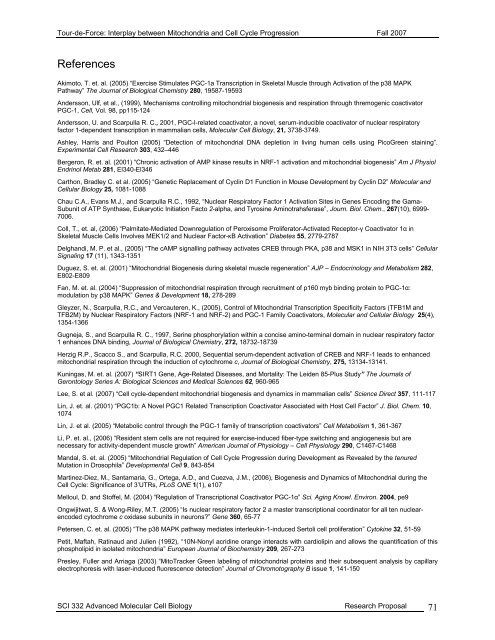Tour-de-Force
Tour-de-Force
Tour-de-Force
Create successful ePaper yourself
Turn your PDF publications into a flip-book with our unique Google optimized e-Paper software.
<strong>Tour</strong>-<strong>de</strong>-<strong>Force</strong>: Interplay between Mitochondria and Cell Cycle Progression Fall 2007ReferencesAkimoto, T. et. al. (2005) “Exercise Stimulates PGC-1a Transcription in Skeletal Muscle through Activation of the p38 MAPKPathway” The Journal of Biological Chemistry 280, 19587-19593An<strong>de</strong>rsson, Ulf, et al., (1999), Mechanisms controlling mitochondrial biogenesis and respiration through thremogenic coactivatorPGC-1, Cell, Vol. 98, pp115-124An<strong>de</strong>rsson, U. and Scarpulla R. C., 2001, PGC-l-related coactivator, a novel, serum-inducible coactivator of nuclear respiratoryfactor 1-<strong>de</strong>pen<strong>de</strong>nt transcription in mammalian cells, Molecular Cell Biology, 21, 3738-3749.Ashley, Harris and Poulton (2005) “Detection of mitochondrial DNA <strong>de</strong>pletion in living human cells using PicoGreen staining”.Experimental Cell Research 303, 432–446Bergeron, R. et. al. (2001) “Chronic activation of AMP kinase results in NRF-1 activation and mitochondrial biogenesis” Am J PhysiolEndrinol Metab 281, El340-El346Carthon, Bradley C. et al. (2005) “Genetic Replacement of Cyclin D1 Function in Mouse Development by Cyclin D2” Molecular andCellular Biology 25, 1081-1088Chau C.A., Evans M.J., and Scarpulla R.C., 1992, “Nuclear Respiratory Factor 1 Activation Sites in Genes Encoding the Gama-Subunit of ATP Synthase, Eukaryotic Initiation Facto 2-alpha, and Tyrosine Aminotrahsferase”, Journ. Biol. Chem., 267(10), 6999-7006.Coll, T., et. al, (2006) “Palmitate-Mediated Downregulation of Peroxisome Proliferator-Activated Receptor-γ Coactivator 1α inSkeletal Muscle Cells Involves MEK1/2 and Nuclear Factor-κB Activation” Diabetes 55, 2779-2787Delghandi, M. P. et al., (2005) “The cAMP signalling pathway activates CREB through PKA, p38 and MSK1 in NIH 3T3 cells” CellularSignaling 17 (11), 1343-1351Duguez, S. et. al. (2001) “Mitochondrial Biogenesis during skeletal muscle regeneration” AJP – Endocrinology and Metabolism 282,E802-E809Fan, M. et. al. (2004) “Suppression of mitochondrial respiration through recruitment of p160 myb binding protein to PGC-1α:modulation by p38 MAPK” Genes & Development 18, 278-289Gleyzer, N., Scarpulla, R.C., and Vercauteren, K., (2005), Control of Mitochondrial Transcription Specificity Factors (TFB1M andTFB2M) by Nuclear Respiratory Factors (NRF-1 and NRF-2) and PGC-1 Family Coactivators, Molecular and Cellular Biology 25(4),1354-1366Gugneja, S., and Scarpulla R. C., 1997, Serine phosphorylation within a concise amino-terminal domain in nuclear respiratory factor1 enhances DNA binding, Journal of Biological Chemistry, 272, 18732-18739Herzig R.P., Scacco S., and Scarpulla, R.C. 2000, Sequential serum-<strong>de</strong>pen<strong>de</strong>nt activation of CREB and NRF-1 leads to enhancedmitochondrial respiration through the induction of cytochrome c, Journal of Biological Chemistry, 275, 13134-13141.Kuningas, M. et. al. (2007) “SIRT1 Gene, Age-Related Diseases, and Mortality: The Lei<strong>de</strong>n 85-Plus Study” The Journals ofGerontology Series A: Biological Sciences and Medical Sciences 62, 960-965Lee, S. et al. (2007) “Cell cycle-<strong>de</strong>pen<strong>de</strong>nt mitochondrial biogenesis and dynamics in mammalian cells” Science Direct 357, 111-117Lin, J. et. al. (2001) “PGC1b: A Novel PGC1 Related Transcription Coactivator Associated with Host Cell Factor” J. Biol. Chem. 10,1074Lin, J. et al. (2005) “Metabolic control through the PGC-1 family of transcription coactivators” Cell Metabolism 1, 361-367Li, P. et. al., (2006) “Resi<strong>de</strong>nt stem cells are not required for exercise-induced fiber-type switching and angiogenesis but arenecessary for activity-<strong>de</strong>pen<strong>de</strong>nt muscle growth” American Journal of Physiology – Cell Physiology 290, C1467-C1468Mandal, S. et. al. (2005) “Mitochondrial Regulation of Cell Cycle Progression during Development as Revealed by the tenuredMutation in Drosophila” Developmental Cell 9, 843-854Martinez-Diez, M., Santamaria, G., Ortega, A.D., and Cuezva, J.M., (2006), Biogenesis and Dynamics of Mitochondrial during theCell Cycle: Significance of 3’UTRs, PLoS ONE 1(1), e107Melloul, D. and Stoffel, M. (2004) “Regulation of Transcriptional Coactivator PGC-1α” Sci. Aging Knowl. Environ. 2004, pe9Ongwijitwat, S. & Wong-Riley, M.T. (2005) “Is nuclear respiratory factor 2 a master transcriptional coordinator for all ten nuclearenco<strong>de</strong>dcytochrome c oxidase subunits in neurons?” Gene 360, 65-77Petersen, C. et. al. (2005) “The p38 MAPK pathway mediates interleukin-1-induced Sertoli cell proliferation” Cytokine 32, 51-59Petit, Maftah, Ratinaud and Julien (1992), “10N-Nonyl acridine orange interacts with cardiolipin and allows the quantification of thisphospholipid in isolated mitochondria” European Journal of Biochemistry 209, 267-273Presley, Fuller and Arriaga (2003) “MitoTracker Green labeling of mitochondrial proteins and their subsequent analysis by capillaryelectrophoresis with laser-induced fluorescence <strong>de</strong>tection” Journal of Chromotography B issue 1, 141-150SCI 332 Advanced Molecular Cell Biology Research Proposal 71
















